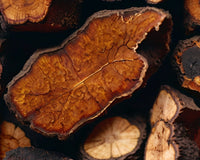What is coconut sugar and how is it made?
Coconut sugar is also known as coconut palm sugar.
It is a natural sugar made from the sap of the coconut tree, the sugary circulating fluid of the coconut tree. It is often confused with jaggery, which is similar but made from a different type of palm tree.
Coconut sugar is made in a natural two-step process:
- The flowers of the coconut tree are cut and the liquid sap is collected into containers.
- Place the juice over heat until most of the water has evaporated.
The final product is brown and grainy. It is similar in color to raw sugar, but the particle size is usually smaller or more variable.
Is it more nutritious than regular sugar?
Regular table sugar and high fructose corn syrup do not contain any important nutrients and therefore provide "empty" calories.
However, coconut sugar does retain quite a bit of the nutrients found in coconut palm.
The most notable of these are the minerals iron, zinc, calcium and potassium, as well as some short-chain fatty acids such as polyphenols and antioxidants.
Then it contains a type of fiber called inulin, which may slow down the absorption of glucose and explains why coconut sugar has a lower glycemic index than regular table sugar.
Even though coconut sugar contains some nutrients, you'll get more from the real food.
Coconut sugar is very high in calories (the same as regular sugar) and you would have to eat a lot of it to meet your needs for the above nutrients.
Coconut sugar may have a lower glycemic index
The GI of glucose is 100. By comparison, a food with a GI of 50 raises blood sugar levels half as much as pure glucose.
Table sugar has a GI of about 60, while coconut sugar has a GI of 54.
However, it is important to note that the GI varies from person to person and may vary from batch to batch of coconut sugar.
Although its inulin content may slow sugar absorption to some extent, it's unclear whether this modest difference in GI is related to health.
it is still rich in fructose
Another possible reason why added sugar is so unhealthy is its high fructose content.
Although not all scientists are convinced that fructose is a serious problem in healthy people, most agree that excess fructose may promote metabolic syndrome in obese individuals.
Regular table sugar (sucrose) is 50% fructose and 50% glucose, while high fructose corn syrup is approximately 55% fructose and 45% glucose.
Despite frequent claims that coconut sugar actually contains no fructose, it is made from 70-80% sucrose, which is half fructose.
For this reason, coconut sugar provides almost the same amount of fructose as regular sugar, gram for gram.
Excessive consumption of added sugar may lead to various problems such as metabolic syndrome, obesity, diabetes, and heart disease.
Although coconut sugar has a slightly better nutritional profile than table sugar, its health effects should be largely similar.
Use coconut sugar in moderation, just as you would regular table sugar.
generalize
It is very similar to regular table sugar, although it is not processed and contains small amounts of nutrients. If you are going to use coconut sugar, use caution.
Coconut sugar is in the same boat as most sugar alternatives. It's healthier than refined sugar, but definitely worse than no added sugar.






3 comments
Eppie
“儘管經常聲稱椰子糖實際上不含果糖,但它由 70-80% 的蔗糖製成,即半果糖。”
這句在說什麼?是在說椰子花糖,還是棕櫚糖 ,還是是混了70-80% 蔗糖的“糖”? 椰子花糖和棕櫚糖是兩樣不同的東西但在這裡又混在一起。
整篇文章像在資料收集上有很多錯誤的地方,也有很多矛盾的地方,椰子花糖的GI升糖指數是35,也不是文章所說的54,反正一個過度活躍的孩子吃了用椰子花糖做的蛋糕不會出現過度活躍的情況,這點應該已經可以證明。 當然也要看看椰子花糖是否純正,是否如文中所說混了蔗糖,如果混了蔗糖,為什麼又可以用以作為比較?
在這篇文章我看到以前打倒椰子油和雞蛋的影子,要到多少年後才可以得到平反?在這過程中我們錯過了多少真正對身體好的東西,反之又用了多少有害的東西取締而影響健康?
張宇君
補充一下,關於最後一句,你說它比精緻糖更健康就已經跟你前面的論述矛盾了,姑且不論這個,關於“絕對比不加糖更糟糕”,這點我並不同意。吃什麼好,吃什麼不好並非絕對,要看什麼人在什麼情況下,比如人們說堅果、蔬菜、糙米、五穀雜糧更健康,但這些對一個腎臟病患來說,可能磷和鉀就過高了,反而白飯更適合他。如果你在肚子餓的時候吃一些添加椰糖的食物,它GI值不高,可以讓你血糖保持平穩,即使找你說的只有“微量”的營養,對於一個營養不良的人來說總是不無小補吧,即便是對一個正常人來說,我也想不出來哪裡會“更糟糕”。
張宇君
現在被鼓吹的是椰子花蜜糖,不是什麼用樹皮做的棕櫚糖。椰子花蜜糖的GI值大概35左右。你單從它的成分看覺得跟其他糖差異沒有太大,那跟很多天然食材裡所含的糖還未萃取出來前也沒有差異太大,畢竟糖就是C6H12O6。這樣的看法是很粗糙的,就算椰子花蜜糖GI值是您說的60好了,單就這點你就無法單看成分去解釋為何它的GI值比較低。
任何食物即使是天然食物本來就不能吃太多,但你不能否認水果裡含的糖比精緻糖好吧。一樣的道理,一樣不過量的情況下,椰子花蜜糖就是比蔗糖天然,比蔗糖好。所有東西吃過量都是毒,即使靈芝、人蔘也不例外。說椰子花蜜糖比較好也不是叫你狂吃,請不要混淆視聽。